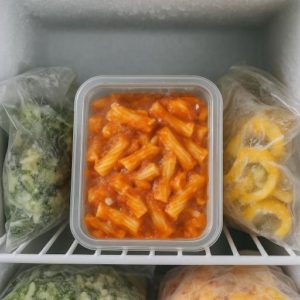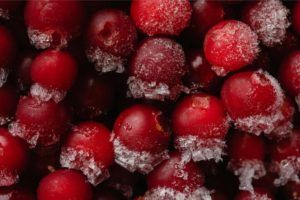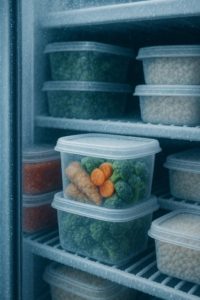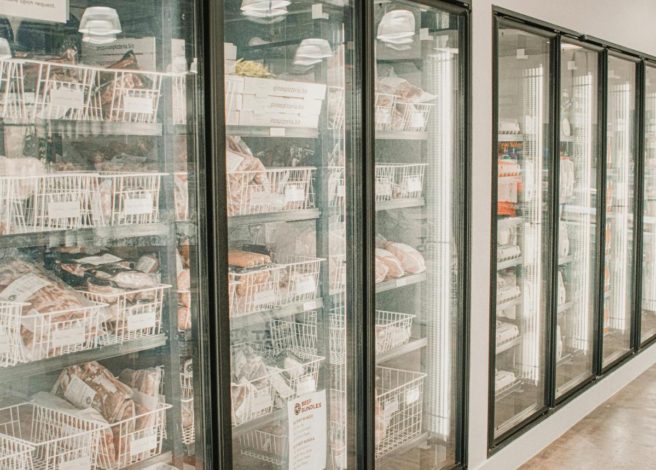-
Packaging in freezers must survive rapid drops to -40°F without cracking or losing clarity.
-
APET with impact modifiers resists cold and stays clear; polypropylene needs additives but can lose transparency.
-
Each manufacturing heat cycle weakens material, making it more brittle in extreme cold.
-
Success means balancing cold resistance, clarity, barrier strength, and insulation.
Have you ever been pushed to the edge? If so, food packaging may be able to sympathize without giving you the ‘cold shoulder.’ Commercial flash freezing operations (see it in action here) push packaging in freezers to their absolute limits. When your products go from room temperature to minus 40 degrees Fahrenheit in seven minutes, failures aren’t just possible — they’re bound to happen if you don’t have the right packaging strategy. Good and bad packaging differ in how materials behave at the molecular level with temperature changes.
At Inline Plastics, we’ve been in the fresh food packaging business for over 55 years and have seen the effects of all kinds of temperatures. Today, we would like to share some key insights with you.
Here’s the good news: you don’t need a PhD in thermodynamics or the criminal genius of Batman’s Mr. Freeze to master this knowledge.
This article explains the science of freezer-grade packaging and shows why some plastics work better than others in freezing conditions. It also offers tips for choosing packaging that protects your products and your profits during the cold chain.
Grab your jackets and put on your learning scarves. Things are about to get chilly (in a fun way)!
What Really Happens During Flash Freezing
Every food product in the freezer aisle faces a significant challenge: extreme temperature drops. These drops can ruin weak packaging in freezers within minutes. Your tasty meals, desserts, and special items rely on strong materials that won’t fail under stress. One packaging breakdown can turn a profit into a devastating loss.
The Forces Working Against Your Packaging in Freezers
 Commercial freezing creates a perfect storm of destructive forces. When temperatures fall fast from warm to freezing, packaging materials face many challenges:
Commercial freezing creates a perfect storm of destructive forces. When temperatures fall fast from warm to freezing, packaging materials face many challenges:
- Thermal shock strikes first, causing rapid contraction that can turn flexible materials brittle.
- Moisture crystallization follows closely behind, which is important in freezing foods, but it creates ice formations that can compromise package integrity.
- Finally, material degradation happens slowly over time. It weakens seals and lowers barrier properties when you need them most.
Understanding Material Science for Better Results
Success in freezer applications requires understanding how different materials respond to extreme cold. Not all packaging materials perform equally when temperatures drop below freezing.
Crystalline vs. Amorphous: The Great Divide
“Crystalline vs. Amorphous” may sound like a sci-fi movie about alien wars, but it means something else entirely in food packaging. These crystalline materials are like snowballs. When you stress them, they scatter light and become opaque. This shows that their structure is compromised. Amorphous materials act like clear ice cubes. They stay transparent and intact, even when under pressure.
This key difference explains why some packages emerge from the freezer cloudy or damaged, while others stay clear and strong.
The PET Advantage in Frozen Applications

Image created using AI.
Polyethylene terephthalate (PET) is a top choice for frozen food packaging. However, some smart changes are needed. Pure PET can crystallize easily in the freezer, so manufacturers make amorphous PET (APET). This blend maintains clarity and helps to avoid crystallization.
Standard PET packaging can typically handle temperatures down to minus 10 degrees Fahrenheit. For extreme applications, specialized freezer-grade formulations use impact modifiers that act like internal plasticizers. These additives improve ductility and prevent brittleness at sub-zero temperatures — even down to minus 30 degrees Celsius. They help keep the material flexible without compromising recyclability or food-contact safety.
The Polypropylene Challenge
While PET excels in many freezer applications, polypropylene (PP) presents a different set of trade-offs. This material typically handles temperatures only down to about 40 degrees Fahrenheit (above freezing) — significantly warmer than PET’s capabilities. To improve its low-temperature performance, manufacturers often create a 50-50 blend of homopolymer and impact copolymer (in plain English: essentially, a rubber additive).
Pure homopolymer polypropylene offers the clearest appearance but remains extremely brittle in cold conditions. Adding impact copolymer makes the material more ductile and better suited for freezer use. However, this improvement comes at a cost: the material develops haze and loses some of its crystal-clear appearance.
In freezer packaging, improving one property usually means compromising another. Success comes from knowing which characteristics are most important for your product.
The Secret Weapon: Intrinsic Viscosity
 A key factor in freezer packaging is “intrinsic viscosity.” This is how well a material keeps its protective properties when faced with stress. Here’s where the science gets even more fascinating — and critical to your bottom line. Every time packaging material undergoes a heat process, it loses intrinsic viscosity points. This happens during both sheet manufacturing and thermoforming. Think of this as the material’s “life force.”
A key factor in freezer packaging is “intrinsic viscosity.” This is how well a material keeps its protective properties when faced with stress. Here’s where the science gets even more fascinating — and critical to your bottom line. Every time packaging material undergoes a heat process, it loses intrinsic viscosity points. This happens during both sheet manufacturing and thermoforming. Think of this as the material’s “life force.”
Fresh material starts with an intrinsic viscosity of around 85 points. Each heat cycle costs roughly three points. When the number falls to 68-70, the material turns “soupy” during processing and becomes much more prone to cracking in freezer applications. Knowing your material’s processing history is key to predicting how well it will perform in a freezer.
The Plot Twist: Barrier Properties and Insulation
Paper packaging is the most popular choice in freezer aisles because it insulates well and helps prevent freezer burn. But it does have a drawback: customers can’t see the products inside.
Modern APET freezer-grade materials incorporate impact modifiers that preserve optical clarity and structural strength at low temperatures — all without relying on glycol-modified PET (PETG). This means you get high-visibility packaging that also delivers the cold resistance you need for your packaging in freezers.
Victory Conditions: Choosing Your Packaging Champion
The path to success with packaging in freezers requires balancing multiple factors:
Temperature resistance determines your lower limit. While standard materials might handle typical freezer temperatures, flash-freezing operations demand specialized formulations.
Clarity requirements matter for consumer appeal. If product visibility drives sales, use impact-modified APET that maintains transparency.
Processing history affects final performance. Understand how many heat cycles your packaging material has endured before it reaches your line.
Barrier properties guard against freezer burn and moisture loss, helping to keep product quality intact during the cold chain.
The Transformation: From Freezer Failures to Frozen Success

Image created using AI.
Success in frozen food packaging isn’t just about the right material. It’s about matching material properties to your specific needs. A premium dessert like your “Sweet Dreams Are Made of Cheese” cheesecake needs clear packaging to show off its beauty. In contrast, a family-sized casserole focuses more on insulation than its appearance.
Winning companies in frozen food know that packaging is a key system. It protects, preserves, and shows off their products, even in harsh conditions along the food supply chain.
Putting Your Worries on Ice
The frozen food market continues expanding, driven by consumer demand for convenience and quality. Success requires more than great recipes. It also requires packaging that works perfectly from the flash freezer to the consumer’s table.
Don’t let packaging failures freeze your profits — partner with suppliers who understand the science behind sub-zero performance. Specify materials based on actual temperature requirements, not just cost considerations. Test thoroughly in real-world conditions, including the extreme temperature changes found in commercial flash-freezing operations.
Your products deserve packaging that’s as exceptional as the food inside. In the unforgiving world of commercial freezing, there’s no room for compromise — only champions survive the cold.
The freezer aisle awaits your perfectly packaged products. Are you ready to take on the challenge?
Do you want to warm up with more fun food packaging information? Visit our Learning Center today and explore a wide range of topics.


